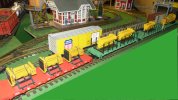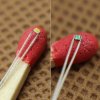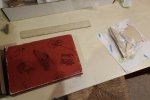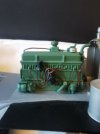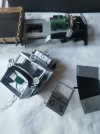You are using an out of date browser. It may not display this or other websites correctly.
You should upgrade or use an alternative browser.
You should upgrade or use an alternative browser.
What happened at your workbench today?
- Thread starter Henri
- Start date
David1226
Registered
I cannot really help you with the diesel generator. I bought it many years ago at a show that I attended, I cannot remember who the trader was. It is a resin copy of the diesel generators on your red wagon. It was not a particularly good copy, there are lots of blow holes in the casting. When I bought it, it was my intention to use it as a wagon load, it was in later years, when I decided to build a crane, that I had the idea of incorporating it into that, as shown in my photo. In that installation, the blow holes are not evident and of course, with the engine bay doors closed, the engine is not visible at all.In post 2249 David 1223 you posted this picture :

I am interested in the motor inside of your wagon.
Is it one that you 3D printed ?
Did you designed the stl file or did you got is from somewhere ?
I would like to extend my string of motors wagons
Here is what I have already
View attachment 309998
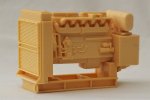
David
David1226
Registered
The construction of the crane and match truck, are finally completed. The next stage is a session in the photo studio. Here is an impromptu shot on the work bench before hand.
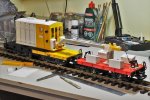
Here are the bits that I was waiting for, a pair of 3D printed fire extinguishers. I made the housings for them from plasticard sheet.
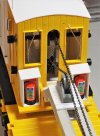
Here is a view of the match truck. The support cradle for the jib and the storage lockers are all fabricated from plasticard sheet.
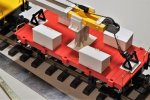
The photo session will be a sort of deconstruct down to component parts, ready to do the usual illustrated write up on how the model was built. I anticipate the painting will take a long time to complete.
David

Here are the bits that I was waiting for, a pair of 3D printed fire extinguishers. I made the housings for them from plasticard sheet.

Here is a view of the match truck. The support cradle for the jib and the storage lockers are all fabricated from plasticard sheet.

The photo session will be a sort of deconstruct down to component parts, ready to do the usual illustrated write up on how the model was built. I anticipate the painting will take a long time to complete.
David
playmofire
Registered
Who produced the fire extinguishers for you, please, David?
David1226
Registered
EbayWho produced the fire extinguishers for you, please, David?
1/18 Scale Fire extinguisher model 2 piece | eBay
David
The Shed
Citizen of the Republic of the North East.
1/24th scale
All products are sold unpainted, they are shown painted on the web site for display purposes only.
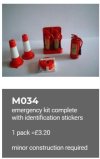
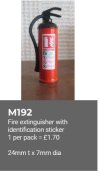

playmofire
Registered
Further info, Phil, from the HRCA site.
"The use of a square brass bar for the footplate valance is a feature of the Leinster loco kits I have made (see photo). However, the Leinster catalogue does not feature this type of loco; but it does point toward an older scratch build.
David
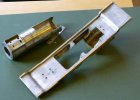 "
"and:
"It seems to have been established that Gordon's locomotive is a 'one off' model. The Midland/LMSR compounds were attractive prototypes for individual, independent, modellers, and for commercial makers too: both Meccano Ltd. and Bassett-Lowke mass produced good representations in '0' gauge , and I believe that Trix also made an '00' version.
One can see why the engine would be popular both with individual model makers and with manufacturers. It became the dominant engine type in the early years of the LMSR (i.e. in the early/mid 1920s), and production of new (full size) engines continued until (I believe) 1932/1933, when Mr William Stanier arrived from Swindon and called a halt! (By then, of course, the 'Royal Scots' had been introduced.)
The engines had been ideal for the - successful - Midland Railway policy of running frequent, fast, and not very heavy trains between the major cities on its network (e.g. London, Leicester, Nottingham, Derby, Manchester, Sheffield/Rotherham, Leeds, Birmingham, etc.). The compounds might have gone on for even longer had not higher authority intervened! For modellers, the engines had the advantages of being handsome and topical - and, having only 4 coupled wheels and a bogie, of being able to negotiate curves of quite small radius.
John"
David1226
Registered
Never mind the LEDs, where did you get those giant matches, they must go off like a solar flare.Phew!
I have finished....
I has bin sod-er-in wires on LEDs..
Small LEDs....
A bit of a trial......
View attachment 310176
PhilP
David
JimmyB
Now retired - trains and fishing
I bought my SMT LEDs ready wired, easy way outI admit they don't all look that neat..
I think I may have 'cooked' two of them, as well.
PhilP
Me too..I bought my SMT LEDs ready wired, easy way out
But I have had these for some time, and decided I really ought to do something with them.
They were bought to populate some OO lighting boards.
Biggest problem, is spill from the LEDs leaking through the plastics of the bodies.
PhilP
Rhinochugger
Retired Oik
OK, I'll post a piccy when I can, but at the moment all there is to see is two heavy books 

Rhinochugger
Retired Oik
Judging by the age of the instruction book, he's been putting it of for a whileIt's a kit!
PhilP
Rhinochugger
Retired Oik
Not as long as the book's subject matterJudging by the age of the instruction book, he's been putting it of for a while
So..........
How far have you got?
PhilP

